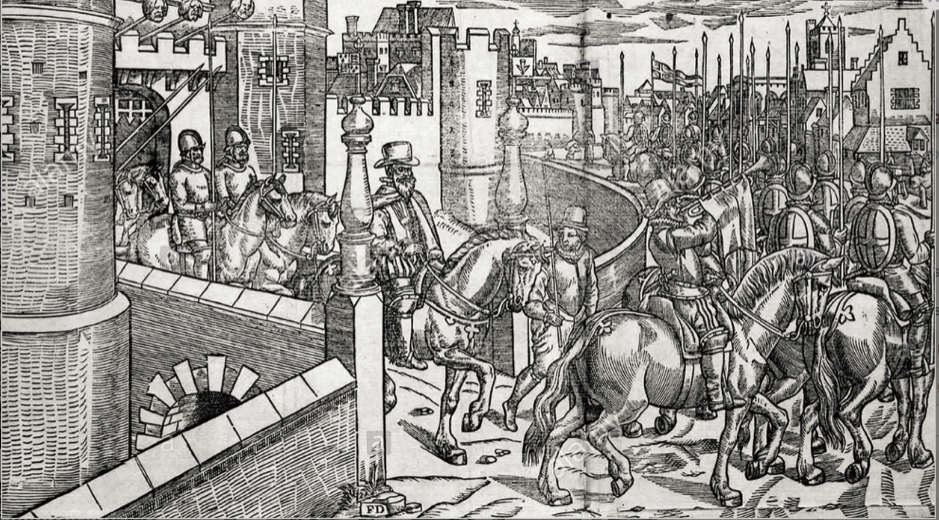Beheadings as honest communication devices
People kill others in different ways, but executions are special in that the killer can choose the method. Practices officially used today are hanging, shooting or stoning, lethal injection, electrocution, gas inhalation, and decapitation. The last method is currently confined to Saudi Arabia, but has a bloody and prestigious history. Many cultures and societies have used it across time, with different social interpretations. In Japan, the honorary suicide was followed by beheading by an assistant, but mere beheading carried shame. Before 1789, only French nobles could be beheaded, and the revolution democratised and extended the practice by guillotining. Today, terrorists use it to great shock value. But what explains the historical popularity of beheading?
A simple explanation would start from physiological affordance. Decapitation guarantees certain death with a simple and quick procedure, provided someone has the skill and will to perform it. But other methods are no less fail-proof while being less messy or violent. Hanging or drowning come to mind, or inflicting mortal wounds by knife or bullet. So was beheading just an epiphenomena of a historical era the appearance of centralised states with their civilisation, restraint, and penal mentality as suggested Norbert Elias and Michel Foucault? I think there may be another intrinsic reason to choose beheading.
Imagine a society before the advent of instant, mass communication. How do you prove that someone was executed? You can witness it or trust the executioners. But how can you prove it beyond doubt to someone not present? In the XVIIth century, Transylvanian Szekler serfs brough Michael the Brave of Wallachia the head of Cardinal Andrew Báthory whom they killed after a battle. They offered a recognizable proof to their ally, who later showed the head to a Papal envoy before it was sawn back to the body before inhumation.
Beheading (including post-mortem) leaves the executioner with a trustworthy proof which is easy to transport and to convince third parties. Other proofs may no less violent, yet offer less certainty. During the extermination of natives in Belgian Congo, bullets were expensive and misused for hunting. The officials asked soldiers to account for each bullet with a human hand as proof of execution. The shocking unintended consequence was an epidemic of mutilations while keeping the victims alive.
“Bring me the head of X” tells not only to kill someone but to give credible evidence of the fact. Such was the fate of John the Baptist when Salome asked Herod for his head on a platter. Moreover, his severed head became a symbolic motif of his martyrdom for Christians widely used in iconography.
 Salome with the Head of John the Baptist – Caravaggio (1610)
Salome with the Head of John the Baptist – Caravaggio (1610)
The gesture of raising the lifeless head after a decapitation ostensively communicates to a large crowd the relevant information about the identity and fate of the victim. So does displaying the head on spikes, wall, or gates to reach a larger audience than those present at the event. The gruesome method is certain to inspire fear, but also to dispel rumours of the victim’s survival.
After William Wallace of Braveheart fame was hanged, drawn, and quartered, his limbs were sent to distant cities of Newcastle, Berwick, Stirling, and Perth, but the head was set on the London Bridge at the core of royal power. Without it, the rest could have come from any other man as, before his actual execution, rumors of his death had been greatly exaggerated. This leads to a testable hypothesis. Many heroes were said to have eluded death. Could we find a negative correlation of survival myths with beheading given the latter’s honest signal?

We could extend the idea to widespread phenomenon of head-hunting in warrior societies. As bodily proof of a killing tally, nothing beats a head given its uniqueness. Their accumulation and preservation over the years gives a personal and group cue of formidability as well as a salient index for private memory or external representation of proficiency in war. In comparison, the states and rulers of complex societies were usually more interested in the identity of the skull than in their quantity. Somewhere in-between we find Tamerlane’s order to his soldiers to bring two heads of enemies each after the fall of Baghdad. So desperate were warriors to satisfy their overlord that they resorted to beheading prisoners or even their own wives.
A second question is whether beheading could stabilise as a social practice even without its communicative purposes. European nobles sentenced to death had a right to be beheaded instead of other execution methods. Rapidity and painlessness might have very well made elites prefer it, but perhaps another explanation was custom. Ironically, beheading might have begun as method to kill important enemies leaving a credible proof while the hoi polloi had to make do with whatever was expedient. But the distinctiveness of being beheaded could have, ulteriorly, signalled the status of the victim irrespective of epistemic concerns of trust in communication. As industrial music group Einstürzende Neubauten called it, guillotine as a “democratic machine” made all heads roll equally. The Great Leveler indeed.
Another hypothesis speaks directly to theories of cultural transformation such as described by Foucault. The gruesomeness of detached heads certainly increased their social cost if “mentalities” changed. But is it also possible that beheadings and other visually-powerful methods of execution or torture have disappeared because their communicative role was replaced by other mechanisms? A weak state or a weak leader needed hard proofs of formidability in punishment but confidence in powerful state institutions and communication media such as journals or recording devices make heads redundant as informational devices. Would the West or fellow countrymen trust or be as frightened by the Islamic State for its lethal determination if it merely announced executions? If anything, democratic societies tend to hide than overtly represent executions or violence, but no-one doubts when they announce the body count.
5 Comments
You must be logged in to post a comment.



Hugo Mercier 17 August 2018 (04:37)
Head hunting in Japan
Brilliant post, thanks Radu, I wish I had thought of it! Just to say that in Japan, the tradition of cutting off heads after seppuku might have come from an older tradition of head hunting, with samurai (or proto-samurai) sporting the heads of their defeated enemies (much like Gauls did, according to Julius Cesar at least).
Radu Umbres 17 August 2018 (11:13)
A high price on one’s head
Thanks Hugo, that blends in nicely with the argument. The causal mechanism seems to be A) you cut the heads of prominent opponents -> B) beheading becomes a status signifier for the victim as well as for the killer -> C) decapitation becomes (partly) decoupled from ostensive communication of identity but remains an ostensive signal of social importance.
Dan Sperber 19 August 2018 (13:59)
Credible evidence of what?
A severed head is conclusive evidence that a head has been severed and that the person it belonged to is dead. But is it conclusive evidence that a given person has died? If John the Baptist were beheaded today, millions of people would already be familiar with his facial features, seen on TV or on the Web, so observing his severed head would be conclusive evidence indeed (seeing a mere picture of the severed head, in the age of photoshopping, is another matter). But had Salome ever encountered John? If not, she couldn’t recognize him. Here was a severed head and Herod’s at least implicit affirmation that it was John’s. Strong but not conclusive. In relatively small-scale societies where the decapitated is known de visu, Radu’s argument is compelling. In other cases, for instance when the head of De Launay, the governor of the Bastille, was carried on a pike in the streets of Paris on July 14, 1789, most people, presumably, couldn’t recognise him. Still they had strong evidence of the anger and violence of the insurgents. A severed head in this and many other cases is relevant not just as evidence that So-and-so had been killed but also, and even more, as awe-inspiring evidence of the determination and ruthlessness of the beheaders.
Victoria Fomina 20 August 2018 (00:07)
Are videos of executions through beheadings perceived as more credible?
Thank you for this very interesting post, Radu. I agree with the idea that beheading, compared to some other execution methods, can provide a more compelling evidence of the fact of the killing (and by extension of the executioner’s ruthlessness). I also think that it might be worth asking to what extent this factor is still relevant in the context of televised beheadings staged by terrorist groups. As Dan pointed out, in the era of Photoshop the authenticity of any video or image is subject to suspicion. However, the phenomenon of filming and circulating beheading videos came into practice before the graphic editing technology became widely available. For instance, the Islamic State’s tradition of producing gruesome beheading recordings can be traced back to the Chechen conflict. Videotaping the executions of Russian soldiers and civilian hostages became a popular practice among the Chechen militants during the late 1990s and early 2000s. They often chose beheading as an execution method, perhaps, not only because of its symbolic meaning and shock effect on the audience, but also because such a video would be more credible, as it is harder to stage a fake execution through beheading (as opposed to shooting or stabbing). The growing development and accessibility of graphic design technologies have certainly affected the perceived credibility of such footages – for instance, some of the beheading videos released by the Islamic State, have in fact been denounced by the experts as fakes. Yet, even in our era of fake news and rising skepticism towards digital mediums, is it possible that the audience would still rate a video-recording of an execution through beheading as more credible compared to a footage of an execution carried out with the methods that do not entail a major damage to the integrity of the body?
Radu Umbres 20 August 2018 (12:31)
Reply to Dan and Victoria
Thank you for your great comments. Indeed, as Dan suggests, decapitations give very credible evidence of ruthlessness even without relying upon the identity of the victim. We could argue, however, that in historical terms small scale society beheadings preceded anonymous large scale societies. And even in the Paris crowd someone could notice that the head belonged to someone else than the Bastilles governor. Moreover, other methods of execution can communicate even better the formidability of the killer – the Romanian prince Vlad the Impaler got his nick-name by impaling both known Romanian boyars and anonymous Saxons or Turks to line up before enemy eyes. Beheading might even communicate restraint and honorary treatment compared to human imagination in executions.
In any case, the viciousness of the act definitely adds to the epistemic certainty of the method, as in Victoria’s great example of Chechen and IS beheadings in the era of fake news. A dual cultural attractor as it were. It might be interesting to know more about the cultural context of decapitation in the Caucasus, and why IS latched on to this salient example. We could also link it with symbolical events for Muslim-Christian wars, such as Saladin (in some accounts personally) decapitating Raynald of Châtillon during the Second Crusade. According to Wikipedia, some communication of identity was involved. “According to Ernoul, Raynald’s head was struck off by Saladin’s mamluks and it was brought to Damascus to be “dragged along the ground to show the Saracens, whom the prince had wronged, that vengeance had been exacted”. When you don’t have access to YouTube or Twitter, physical heads seems to carry the message quite well.